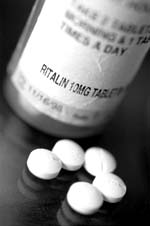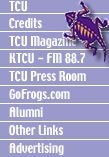|
Tuesday,
November 20, 2001
Doctor-prescribed
ritalin becomes newest ‘party’ drug
By
Martha Irvine
Associated press
She had
no idea she had a popular party drug on hand.
To her,
the vial of prescription pills she’d once been given
to treat attention deficit disorder were just leftovers, until
a friend from New York called to ask if she’d mail out
a few — just for fun.
The woman,
a 29-year-old San Diego resident, didn’t do it. But she
and her friends were intrigued.
“We
said, ‘We should just try it. It could be fun,’”
says the woman who, on the condition that she not be named,
told how they partied on the drug once this summer and again
in September.
In this
case, the stimulant of choice was Adderall, an amphetamine.
Others use methylphenidate, another attention-deficit drug
more widely known by one of its brand names: Ritalin.
Whatever
the type, authorities are concerned about ADD drug abuse.
Some
unprescribed users are adults. But experts say many are young
people — a good number of them grade schoolers, who get
the drugs from peers being treated for ADD.
“They’ve
got pretty easy access to it,” says Steve Walton, a detective
with the Calgary Police Service in Canada and author of the
book “First Response Guide to Street Drugs.”
Users
often crush the pills and snort them to get a cocaine-like
rush.
Walton
says he’s also found youth who frequent the rave dance-party
scene “stacking” the drug Ecstasy with Ritalin to
try and prolong their high. He calls the practice “alarming.”
Reports
of ADD stimulant abuse continue to surface in this country,
too. They include the case of two rural teens arrested in
January for stealing $9,700 worth of drugs, including Ritalin
and amphetamines, from a pharmacy in tiny Lacon, Ill.
In March,
11 sixth-graders in Scituate, R.I., were suspended for buying
and selling prescription drugs, including Adderall and Concerta,
a newer form of methylphenidate.
Surveys
of young people — from Massachusetts to the Midwest —
also have documented the trend.
One of
them, published in this month’s Psychology in the Schools
journal, focused on 651 students, ages 11 to 18, from Wisconsin
and Minnesota.
Researchers
found that more than a third of students who took attention-deficit
medication said they’d been asked to sell or trade their
drugs. And more than half of students who weren’t prescribed
the medication said they knew students who gave away or sold
their medication.
“I’ve
been trying to tell anyone who will listen,” says William
Frankenberger, study co-author and a psychology professor
at the University of Wisconsin-Eau Claire. “People don’t
realize what these drugs are — and that the similarities
between them and cocaine are much greater than the differences.”
Officials
at the federal Drug Enforcement Administration say abuse of
prescription stimulants became more common in the last five
years, as production of Ritalin increased and other drugs
were introduced into the marketplace.
But some,
including doctors, wonder if new “time-release”
versions of the drugs are slowing the abuse.
They include
Concerta, taken just once a day — so an ADD child doesn’t
have to bring the drugs to school. Time-release versions are
also more difficult to crush and, thus, snort, says Dr. Timothy
Wilens, a Harvard Medical School psychiatry professor.
A national
survey released in September by the General Accounting Office
found that only 8 percent of principals said stimulant drugs
were abused or stolen in their schools in the 2000-2001 school
year. Most of those said they knew of only one incident.
But Terrance
Woodworth, deputy director of the DEA’s diversion control
office, isn’t convinced that abuse is down.
In fact,
he thinks the age range is expanding — even as makers
of some of the drugs, including Ritalin, have launched their
own education campaigns to try to curb misuse.
“The
kids who were abusing in junior high and high school are now
in college,” Woodworth says. That has caused some colleges,
including the University of Wisconsin, to tighten prescription-writing
procedures for such drugs as Ritalin, which some students
call “Vitamin R” and use to help them pull all-nighters.
Although
alcohol abuse remains a much worse and visible problem, students
on the Madison campus can only get one prescription per month
— and only enough pills for that month, says Dr. Eric
Heiligenstein, clinical director of psychiatry at the University
of Wisconsin Health Services.
At Harvard,
Wilens advises his patients, especially students, to “keep
their medications locked away in clandestine places so that
strays don’t steal it from them.”
He says
those on the medication aren’t usually the abusers. In
fact, a study he presented last month at the American Academy
of Child and Adolescent Psychiatry conference found that those
who were treated with prescription stimulants were half as
likely to abuse alcohol or drugs.
For her
part, the 29-year-old from San Diego says she has no plans
to party with Adderall again.
“I
just try to remember how I felt after,” she says, recounting
that a feeling of “utmost clarity” turned to insomnia
and left her “crashed out and overdone” the following
day.
Then in the next breath, she admits she’s kept 20 of
the pills.
“I
don’t know why,” she says. “Maybe for a special
occasion.”
|
